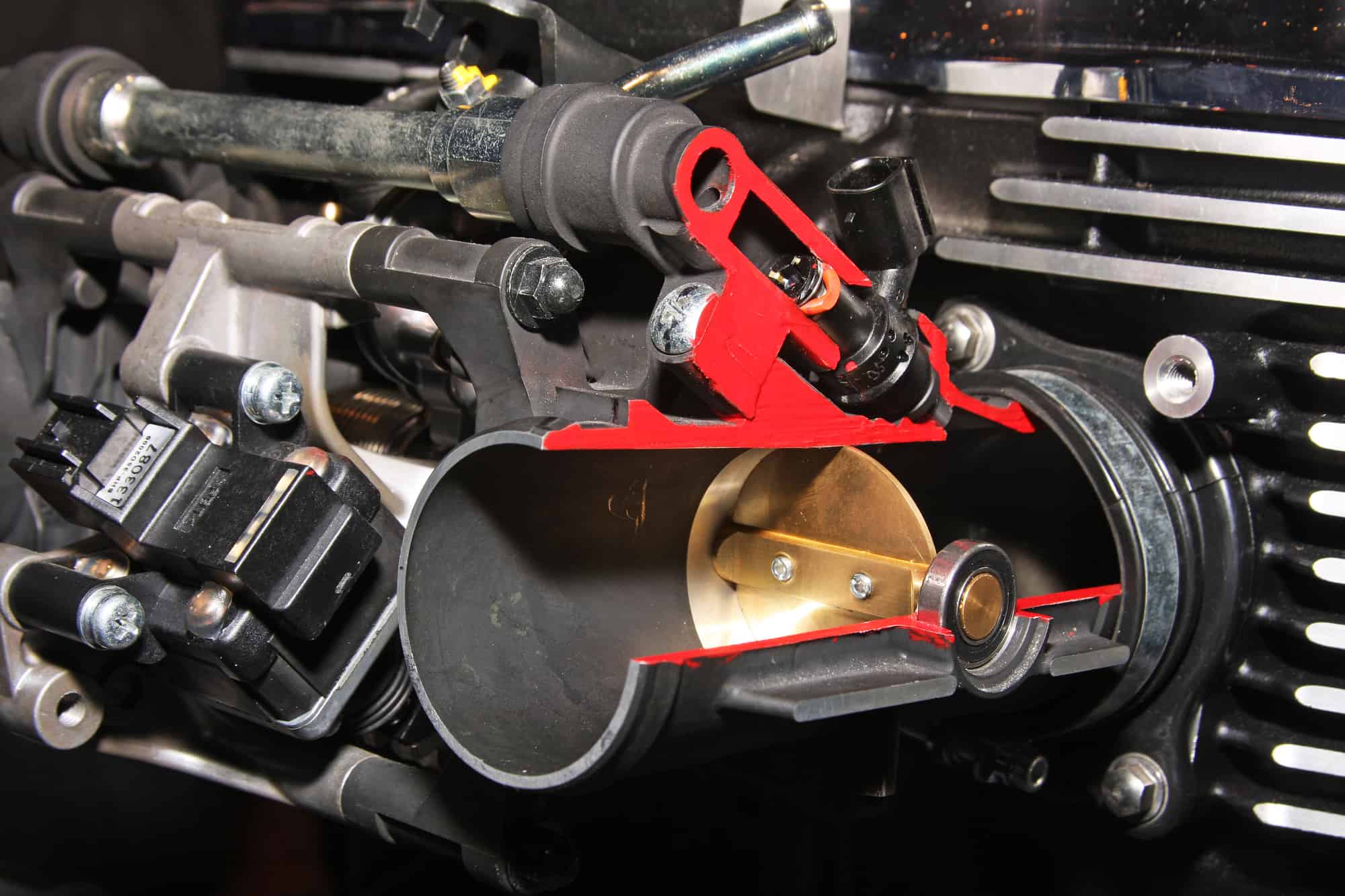A problem with one or both of the throttle position sensors in your car can cause serious engine performance problems. If the trouble code P0121 is also present, this can further confirm the problem to be TPS related, but what exactly does P0121 mean?
As a general rule, P0121 OBD-II Trouble Code: TPS “A” Circuit Range Performance Problem is caused by a disparity between the return signals of the throttle position sensors. It is usually caused by a fault with one of the throttle positions sensors or wiring loom.
What Does P0121 Mean?
The engine code P0121 is stored in memory when the Electronic Control Unit (ECU) detects a value that is out of the expected range in the Throttle Position Sensor “A”.
The Throttle Position Sensor (TPS) is in charge of reporting to the ECU, the aperture of the throttle based on the driver’s pressure on the accelerator pedal. The TPS information in conjunction with the APP signal value is in turn used by the ECU to adjust fuel delivery, spark timing and many other factors based on the driver’s needs (acceleration or deceleration).
Similar to the Accelerator Pedal Position sensor (APP), vehicles equipped with Electronic Throttle Control (ETC) usually count with two integrated TPS sensors. The values of TPA “A” circuit and TPS “B” circuit (also know as TPS1 and TPS2 circuits) are constantly compared by the ECU.
The P0121 code is set when the ECU detects a disparity often called “disagreement” between the returning signals from the TPS circuit “A” and TPS circuit “B”. This code also triggers the ECU “failsafe” routine that greatly varies from one carmaker to the other.
4 Symptoms Of Trouble Code P0121
- Check Engine Light (CEL) lit.
- Possible lags in acceleration (depending on ECU failsafe programming)
- Possible rough idle (depending on ECU programming)
- Possible lack of power (depending on ECU failsafe programming)
What Causes Trouble Code P0121
The most common causes of data trouble code P0121 are:
- Throttle Position Sensor/Electronic Throttle Control wiring (open, shorted, burnt)
- Damaged Throttle Position Sensor/Electronic Throttle Control connector (loosely, corroded, disconnected or bent pins)
- Faulty Throttle Position Sensor and/or faulty Electronic Throttle Control.
How To Diagnose Trouble Code P0121
For the purpose of this article, it’s assumed that you have a basic knowledge of safety precautions while working on your vehicle.
Always refer to the appropriate OEM literature when possible. Original manufacturer diagnostic procedures should always have precedence over a generic workflow.
That said, let’s start the diagnostic process!
1. Preliminary steps
To discard a possible intermittent DTC condition, you’ll need to clear the ECU memory and complete a driving cycle.
- Read data trouble codes and take note of them.
- Clear data trouble codes memory.
- Perform a driving cycle (at least 5-10 minutes).
In case the Check Engine Light stays off then you may have an intermittent problem. If the light lit during your driving cycle then continue with the diagnostic process.
2. Visual Inspection
> TPS sensor condition: to inspect the TPS condition you will need to remove it from the vehicle. Usually, the Throttle Position Sensor is the same piece as the Throttle body (on ETC systems). Check for any unusual condition like a broken sensor, broken wire, etc.
> TPS sensor wiring and connector: perform a meticulous visual inspection of the Throttle Position Sensor wiring and connectors. Look for burnt, damaged, corroded or deteriorated wires, also unplug the sensor and look for bent terminal pins, loosely connections, corrosion or any other possible indication of a bad connection.
Fix any wiring problem before continuing.
3. Electrical Tests
> TPS sensor electrical tests: using the appropriate OEM literature, check the sensor signal, and the reference voltage of the TPS sensor. Reference voltage should be greater than 4.5V. Repair any circuit line as necessary.
4. Scan Tool Tests
> Throttle Position Sensor test: Depending on your vehicle and automotive scanner, you should be able to see on screen the actual Throttle Position Sensor 1 (TPS1) and Throttle Position Sensor 2 (TPS2) signal values.
These values may be expressed on voltage, aperture percentage, or degrees.
Turn the key on, engine off (KOEO) and press the pedal to its wide open throttle position and then let it close again. Slowly depress the pedal and repeat again.
Watch the TPS1 and TPS2 readings. Graph the two values if possible. Both readings should be similar. If you see a significative difference between the values or one of them does not change while pressing the pedal then you should replace the sensor.
What Does Error Code P0011 Have to Do with TPS Circuit Range Performance?
Error Code P0011 relates to the TPS circuit range performance. When this code appears, it usually indicates issues with the camshaft position timing insights. This can affect the overall engine performance and may result in poor fuel economy and increased emissions. It is crucial to address this issue promptly to avoid further damage.
What Could Cause Multiple OBD-II Trouble Codes to Appear in My Vehicle?
When multiple OBD-II trouble codes appear in your vehicle, it could be due to a faulty throttle actuator control motor. This component can cause issues such as erratic idling, loss of power, and poor fuel economy. It is essential to address this issue promptly to prevent further damage to your vehicle.
What Could Cause Multiple OBD-II Trouble Codes to Occur Simultaneously?
When multiple OBD-II trouble codes occur simultaneously, it may indicate a potential issue with the exploring camshaft position actuator circuit. This could be caused by wiring issues, a faulty actuator, or a problem with the sensor. Diagnosing and addressing these issues promptly is crucial in preventing further damage to the vehicle.
How To Repair Trouble Code P0121
Depending on the diagnostics results you may need to do the following:
- Replace the Throttle Position Sensor sensor or Electronic Throttle Control .
- Repair the Throttle Position Sensor wiring/connector or Electronic Throttle Control wiring/connector.
OBD-II Trouble Code P0121 Summary
- P0121 Technical Definition: Throttle Position Sensor (TPS) “A” Circuit Range Performance Problem
- P0121 Meaning: Throttle Position Sensor “A” not working as expected
- Most common cause: Faulty throttle position sensor or wiring
- Risks for the engine/driver: MEDIUM It is recommended that you don’t drive the car and get it checkout as soon as possible
- Emissions severity: LOW. This should not affect emissions testing
- Estimated repair time: 1-2 days
- Estimated repair cost: $100-300
As an Amazon Associate we earn from qualifying purchases.









I’ve noticed my car struggling with acceleration and idling roughly lately. Could these issues be related to the throttle position sensor, and if so, how do I diagnose it myself before taking it to a mechanic?
I’ve been noticing some sporadic lags in acceleration and my Check Engine Light recently turned on. Could these symptoms be indicative of the P0121 code, and if so, what initial steps can I take myself before seeking professional help?